Gallery
- Milestones from the area of Montcada i Reixac
- Baetylus from the Iberian settlement of Les Maleses
- Carved stone from the Iberian settlement of Les Maleses
The aim of the Montcada Municipal Museum (Catalan : Museu Municipal de Montcada), founded in 1982 [1] and housed in the old Casa de la Vila de Montcada i Reixac (Spain) since 1987, aims to recover, conserve and protect local heritage. Among its collection, it is worth mentioning the findings from the Iberian settlement of Les Maleses, in the Catalan Coastal Range in the outskirts of Montcada. The museum also has a permanent exhibition divided into five areas: the environment, mineralogy and palaeontology; prehistory; the Iberian world; medieval and modern Montcada; and, finally, contemporary Montcada. [2] The Museum is part of the Barcelona Provincial Council Local Museum Network.

Vallès Occidental is a comarca (county) in the Barcelona region in Catalonia (Spain). It has two capitals, Sabadell and Terrassa. Along with Vallès Oriental, it forms the historical Vallès region.
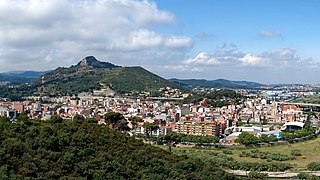
Montcada i Reixac, often referred to as simply Montcada, is a municipality in the comarca of the Vallès Occidental in Catalonia, Spain. It is situated at the confluence of the Ripoll river and the Besós river, and very close to the northernmost neighbourhoods of the city of Barcelona and is therefore a part of the metropolitan area of Barcelona. It had 33,656 inhabitants according to the 2010 census.

The Monastery of Pedralbes, otherwise the Royal Monastery of Santa Maria de Pedralbes is a Gothic monastery in Barcelona, Catalonia, Spain. It is now a museum, housing permanent exhibitions on its own art and legacy as well as third-party special exhibitions from time to time. The Chapel of St. Michael was restored and re-opened in 2018.
TramVallès, Tramvallès or Tramvia del Vallès is a proposed tram or light rail network in the metropolitan area of Barcelona. Its name stems from the region of Vallès, which spans two counties north of the Catalan capital. The region is densely populated, includes the Autonomous University of Barcelona and current public transport services are insufficient for commuters. Following expressions of citizen support, the Generalitat de Catalunya, the governing body of Catalonia, approved the project in 2010. Tramvallès would serve the following municipalities: Montcada i Reixac, Ripollet, Cerdanyola del Vallès, Badia del Vallès, Sant Cugat del Vallès, Barberà del Vallès, Sabadell and Terrassa.
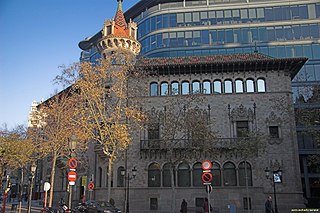
The Barcelona Provincial Council Local Museum Network, also known as Catalonia’s Biggest Museum, is a tool for support and collaboration from and for the museums of the province, which makes available to municipalities a series of services and actions aimed at improving, through the provision of direct services and research into viable formulas for supramunicipal cooperation, the management, conservation and dissemination of heritage and the museum facilities of the towns of Barcelona province. It is managed from the Cultural Heritage Office, which in turn depends on the Department of Knowledge and New Technologies of Barcelona Provincial Council.

The Cercs Mine Museum is a museum dedicated to coal mining, located in the Sant Corneli colony, in the Cercs municipal area, in the region of El Berguedà. It is a technology and history museum that describes the relationship between coal and the geological environment, the landscape, the economy and the people of L’Alt Berguedà.

The Cerdanyola Art Museum, also known as Can Domènech, is an art museum located in the old quarter of the city of Cerdanyola del Vallès. It was opened on 10 September 2009 and is part of the Barcelona Provincial Council Local Museum Network and of the Art Nouveau European Route.

The Cerdanyola Museum is a museum in Cerdanyola del Vallès, Vallès Occidental, Catalonia, Spain. It is guided by the belief that the museum is the territory itself and comprises a group of spaces spread throughout the area. The museum’s objective is to offer a didactic approach to the evolution of the population of this area of El Vallès, following the thread of its history from prehistory to the present day. The Museum is part of the Barcelona Provincial Council Local Museum Network.

The L’Hospitalet Museum, in L'Hospitalet de Llobregat (Barcelonès), is a municipally owned cultural facility that aims to disseminate and conserve the cultural heritage and resources of L'Hospitalet. The museum was opened in 1972 in Casa Espanya, built in the 16th century, and is part of the Barcelona Provincial Council Local Museum Network.

The El Masnou Municipal Nautical Museum is a municipally owned museum, the backbone of which is El Masnou’s relationship with the sea. It is part of the Barcelona Provincial Council Local Museum Network, the Maritime Museums of the Catalan Coast Network and the Mediterranean Maritime Museum Association.

The Mataró Museum is a museum in Mataró, in El Maresme, with a central office in Can Serra, a fortified Renaissance building dating back to 1565. The museum, which is part of the Barcelona Provincial Council Local Museum Network, also manages the different local heritage centres, such as:

The Montmeló Municipal Museum is a museum in the town of Montmeló, Catalonia, Spain. The museum is located in an old manor house, Can Caballé, which was built around 1920. In 1987, the town council bought the building and in 1996 approved its refurbishment as the home of the future museum, which opened in 1998. The Museum is part of the Barcelona Provincial Council Local Museum Network.
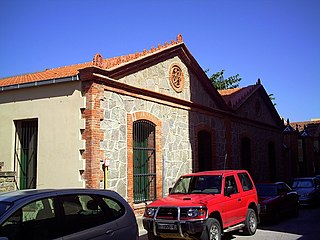
The Premià de Mar Printing Museum, located in the old gas factory of the town, is a museum dedicated to explaining the history of textile printing in Premià de Mar and all of Catalonia. It is part of Science and Technology Museum of Catalonia and the Barcelona Provincial Council Local Museum Network. Its main objective is to expose samples and objects related to textile printing and to explain the techniques used over time, as well as to highlight the important role that this economic activity has played in the past as a driver of industrialisation in Catalonia.

The L’Esquerda Archaeological Museum, located in Roda de Ter, was opened in 1988 as a place to house the material from the archaeological excavations at the L'Esquerda site and bring the findings closer to the public. It is part of the Barcelona Provincial Council Local Museum Network and 'The Iberian Route', organised by the Archaeological Museum of Catalonia (MAC).
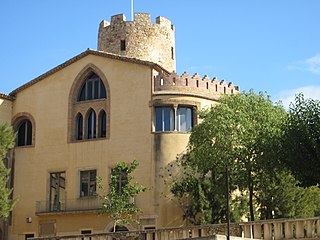
The Balldovina Tower Museum of Santa Coloma de Gramenet in Catalonia, Spain, is a local pluridisciplinary museum, the aim of which is to protect, conserve, study and disseminate the cultural and natural heritage of the territory. The museum, which is part of the Barcelona Provincial Council Local Museum Network, looks after its own collections as well as the monumental heritage of the town of Santa Coloma.

The Textile Museum and Documentation Centre is a museum institution located in Terrassa, a city with an important textile tradition. Managed by a consortium consisting of Terrassa Town Council and Diputació de Barcelona, it presents a panoramic view of the different styles and techniques used all over the world in fabric making throughout history. It is part of the Barcelona Provincial Council Local Museum Network.

El Camp de les Lloses was a Roman settlement located in the area around present-day Tona (Osona) and founded between the 2nd and 1st centuries BC.
The Vilassar de Mar Municipal Museum is a local museum in Vilassar de Mar comprising two facilities: The Marina Museum, focusing on local history and placing special emphasis on its connection with the nautical world, and the Monjo Museum, which tells the story behind the legacy of Vilassar de Mar sculptor Enric Monjo.
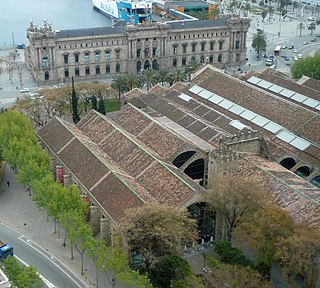
The Maritime Museum of Barcelona is located in the building of Drassanes Reials de Barcelona, the royal arsenal of Barcelona, dedicated to shipbuilding between the thirteenth century and eighteenth century. The first mention of these arsenals date from 1243 in a document indicating the boundaries of the city of Barcelona where it mentions its shipyard.

Opened in 2002, the Fishing Museum is dedicated to fishing knowledge and dissemination, and Costa Brava's maritime heritage. Located in the Palamós fishing port in an old warehouse called "Tinglado", the permanent exhibition explains the history, current affairs and sustainable fishing in Costa Brava's future.